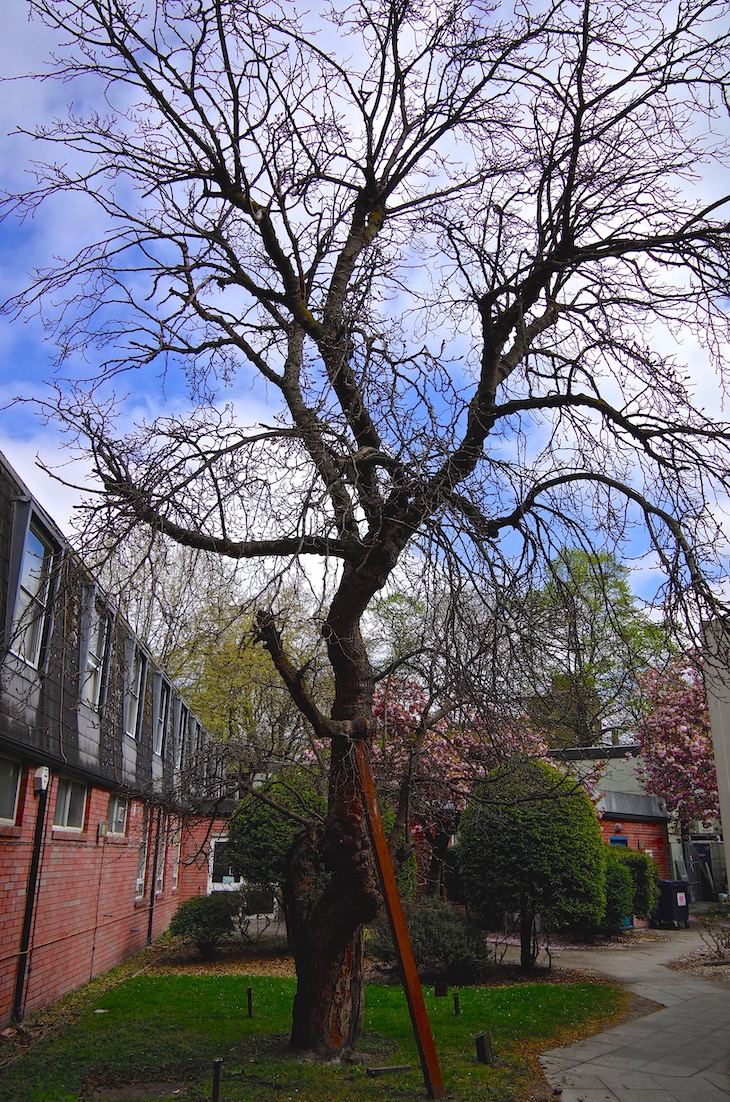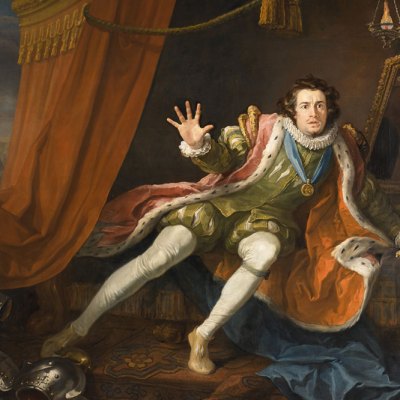The oldest tree in the East End is a black mulberry in Bethnal Green. Since 2017, it has also been the subject of furious dispute. The developers Crest Nicholson want to move it out of the way of a planned block of luxury flats, just 35 per cent of them ‘affordable’. After three years of campaigning, and an online petition garnering more than 16,000 signatures, local residents have secured it a temporary stay of execution (the campaigners argue that relocating the tree, as Crest Nicholson and Tower Hamlets Council have agreed to do, will likely kill it). In January, the High Court ordered a judicial review of the proposals (scheduled for 4–5 May). The Bethnal Green tree is not the only mulberry in London under threat. Six miles away, residents of the Park View Estate in Islington are beginning their own similar challenge, to developers’ proposals to fell a 70-year-old tree from which they still make annual mulberry jam.
The Bethnal Green mulberry tree. Photo: The Gentle Author

Mulberry trees have a distinctive status in Britain. They are non-native, and do not self-seed, so every survivor has been deliberately grown from seeds or, more likely, a rooted cutting. London’s mulberries – primarily the black mulberry, or morus nigra – tell the stories of successive historical interventions in the landscape, and the gradual sprawl of the metropolis. There are plenty to explore: ‘Morus Londinium’, a Heritage Lottery Funded initiative to record every mulberry within the M25, lists more than 700 and counting, identifying a tree in Syon Park, planted in 1548, as the oldest. The morus nigra was probably first brought to Britain by the Romans, who had medicinal uses for the dark, succulent berries. Mulberries remained a medicinal staple in monastic herb gardens (including Syon Park), until they were swept away by Henry VIII.
Many trees that endure today have significant associations. Until 2017, when it was damaged by strong winds and felled, a gnarly, knobbly black mulberry protruded from the concrete car park outside Emmi’s Corner Shop, in Streatham, SW16. It stood on the former kitchen garden of Streatham Park, Hester and Henry Thrale’s country villa six miles outside London. The mulberry is said to be the one under which Hester Thrale and Dr Johnson spent happy hours in conversation. The Bethnal Green mulberry is probably older than this. Crest Nicholson’s luxury flats are located on the former site of the home of Edmund Bonner (c. 1500–69), and the tree may even have been contemporary with the man himself. Bishop Bonner was a key figure in the persecution of Protestants under Henry VIII’s daughter, Mary, and a tradition at least as old as 1911 – the date on an inscription on a commemorative inkwell in the Royal London Hospital in Whitechapel – has it that ‘Bloody Bonner’ sat beneath this tree while deciding which heretics to burn. It is a macabre twist on the bucolic vision of Johnson and Mrs Thrale, but the black mulberry has always had a grisly side. Ovid’s Metamorphoses describes Pyramus stabbing himself for love of Thisbe with such force that his blood splattered the leaves, berries and roots of a nearby tree, marking the species forever. Locals in Haggerston reportedly wanted none of this kind of thing: in the 20th century two mulberries were felled after their owners got fed up with birds dropping the thick, indelibly crimson berries on their washing.
Woodblock illustration by David Kandel from an edition of Hieronymus Bock’s Kreuterbuch (1546), depicting Pyramus and Thisbe beneath a mulberry tree. Hagströmer Library, Stockholm

In the East End, mulberries are most frequently linked to the textile trade. Their leaves are the favourite food of silkworms and in ancient China, where silk was first developed, mulberries enjoyed a special status. Fines for certain civil crimes were exacted in mulberry plantings. Italy and France offered their own government incentives for large-scale planting in the 13th and 15th centuries, and in 1607 James I followed suit in England. Mulberries sprang up in stately homes across the country – possibly including the tree at New Place, Stratford, home of William Shakespeare. However, a proper British silk industry had to wait until the arrival of Huguenot weavers from France in the 1700s. Most settled in Spitalfields, and many planted mulberries in their gardens, as a practical tool of the trade – and, perhaps, a reminder of home.
In the 19th century, as the slums of the East End were ravaged by tuberculosis, Bishop Bonner’s gardens gave way to the London Chest Hospital. The Bethnal Green mulberry appears on a picture postcard of 1930, beside the Hospital Chapel. The Chapel was destroyed by bombs 11 years later, but the mulberry survived with only a charred, split scar. The Bethnal Green mulberry therefore embodies much of the distinctive history of the East End, which has faced down disease and the Luftwaffe and provided a haven for refugees. There is a bathetic quality to the idea that its time may at last have come.
The threatened mulberry tree on the Park View Estate, Islington. Photo: Thomas Marks



